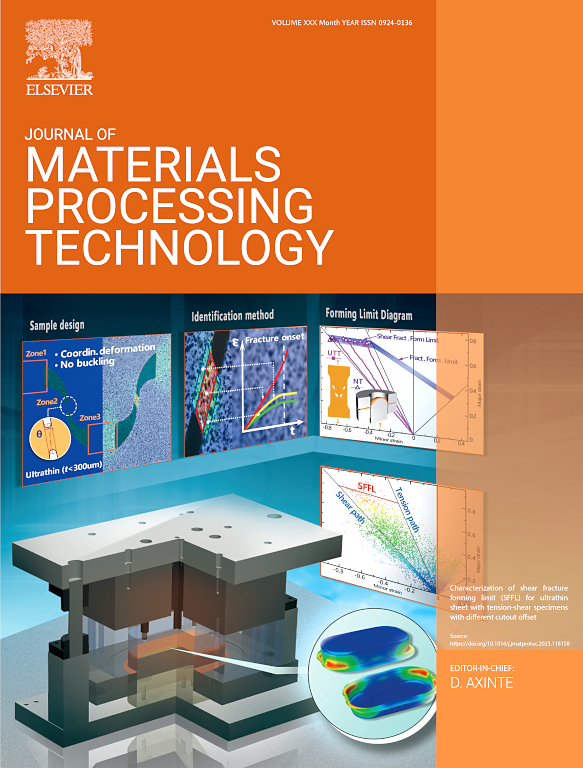ph驱动的界面键动力学使得用CeO2基浆料对熔融二氧化硅进行高效低损伤抛光成为可能
IF 6.7
2区 材料科学
Q1 ENGINEERING, INDUSTRIAL
Journal of Materials Processing Technology
Pub Date : 2025-05-12
DOI:10.1016/j.jmatprotec.2025.118896
引用次数: 0
摘要
由于熔融石英的高硬度和脆性,在保持高材料去除率(MRR)的同时,实现原子级表面完整性仍然是抛光的基本挑战。本研究为理解ph驱动的界面键动力学如何控制化学机械抛光过程建立了一个新的机制框架。通过将多尺度实验表征(XPS, FTIR, Raman光谱)与ReaxFF分子动力学模拟相结合,我们首次证明了Ce-O-Si界面键形成和断裂之间的动态平衡直接控制着去除效率和表面质量。碱性条件下OH -活性增强,有利于Si-O键水解和稳定Ce-O-Si键形成,MRR最高(397.6 nm/min)。酸性环境促进柠檬酸盐介导的Ce3+络合和纳米团簇分散,使滚动机制实现超光滑表面(Sq = 0.086 nm)。相比之下,中性pH条件受到PEG吸附阻断活性位点的影响,导致MRR相对于碱性系统降低62% %。与SiO2磨料相比,MRR增加了12.2倍(32.67 nm/min),证实了化学界面动力学,而不是单独的机械磨损,对材料去除至关重要。这一根本性的进步为设计高效、低损伤的光学材料及其他光学材料的精密抛光工艺提供了广泛的理论基础。本文章由计算机程序翻译,如有差异,请以英文原文为准。
pH-driven interfacial bond dynamics enable high-efficiency low-damage polishing of fused silica with CeO2 based slurries
Achieving atomic-level surface integrity while maintaining a high material removal rate (MRR) remains a fundamental challenge in the polishing of fused silica due to its high hardness and brittleness. This study establishes a novel mechanistic framework for understanding how pH-driven interfacial bond dynamics govern chemo-mechanical polishing processes. By integrating multiscale experimental characterization (XPS, FTIR, Raman spectroscopy) with ReaxFF molecular dynamics simulations, we demonstrate for the first time that the dynamic equilibrium between the formation and rupture of Ce–O–Si interfacial bonds directly control removal efficiency and surface quality. Alkaline conditions enhance OH– activity, facilitating Si–O bond hydrolysis and stable Ce–O–Si linkage formation, resulting in the highest MRR (397.6 nm/min). Acidic environments promote citrate-mediated Ce3+ complexation and nanocluster dispersion, enabling a rolling mechanism that achieves ultra-smooth surfaces (Sq = 0.086 nm). In contrast, neutral pH conditions suffer from PEG adsorption blocking active sites, leading to a 62 % reduction in MRR relative to alkaline systems. A 12.2-fold increase in MRR compared to SiO2 abrasives (32.67 nm/min) confirms that chemical interfacial dynamics, rather than mechanical abrasion alone, are critical to material removal. This fundamental advancement provides a broadly generalizable theoretical basis for designing efficient, low-damage precision polishing processes across oxide-based optical materials and beyond.
求助全文
通过发布文献求助,成功后即可免费获取论文全文。
去求助
来源期刊

Journal of Materials Processing Technology
工程技术-材料科学:综合
CiteScore
12.60
自引率
4.80%
发文量
403
审稿时长
29 days
期刊介绍:
The Journal of Materials Processing Technology covers the processing techniques used in manufacturing components from metals and other materials. The journal aims to publish full research papers of original, significant and rigorous work and so to contribute to increased production efficiency and improved component performance.
Areas of interest to the journal include:
• Casting, forming and machining
• Additive processing and joining technologies
• The evolution of material properties under the specific conditions met in manufacturing processes
• Surface engineering when it relates specifically to a manufacturing process
• Design and behavior of equipment and tools.
 求助内容:
求助内容: 应助结果提醒方式:
应助结果提醒方式:


